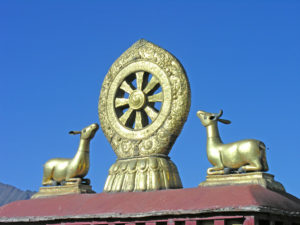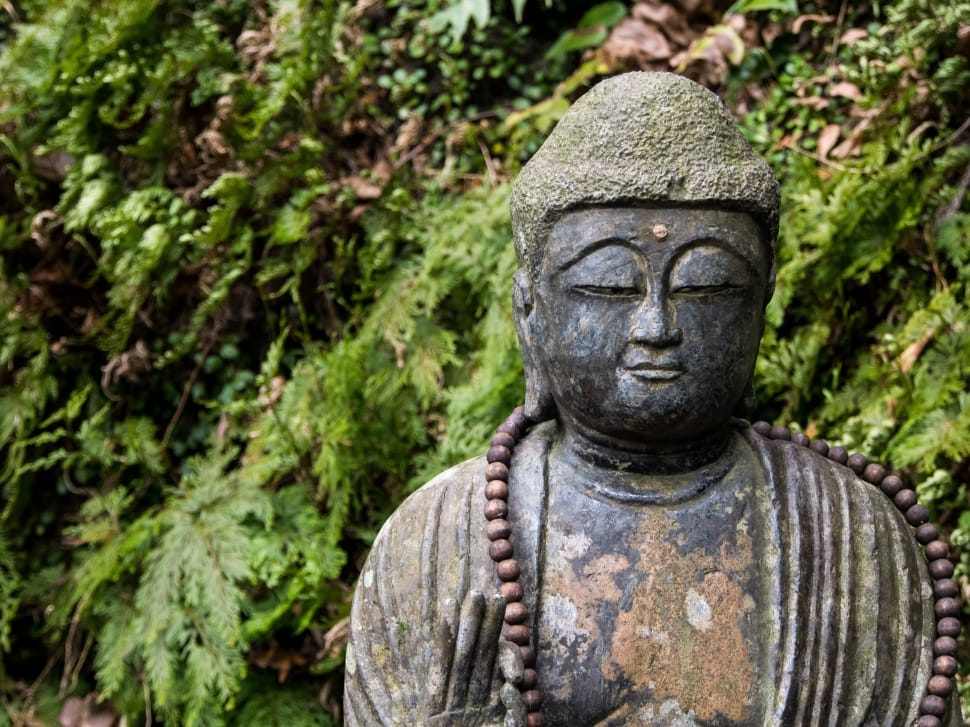The middle path in Buddhism is not often seen to be the same middle path as being depicted in more modernistic New Age religions.
New Age religions usually say to take the middle path rather than taking either the low or the high road. They are referring here to walking the thin line, or about walking along the razor’s edge between good and evil, or between all of the other dualities. It is about not taking sides, or becoming attached too much to a particular side.
Buddhism is really talking about the same middle path as this though. The middle path means neutral in their teachings. A person should remain unbiased and detached, and study both sides of a position. When somebody leans too much to one side or the other, they will incur Karma, or repercussions, for having done so.
This is the law of cause and effect working.
The middle path restores one to be neutral, or, in other words, it helps to return them to living from the emptiness of the Universe, rather than from the fullness of themselves.
It is claimed that the world itself is essentially unreal, but this is more in the way that it is pictured to be within, or because of the overall prevailing state of emptiness. Realness is not permanent but fleeting, or moving, coming and going. You only see this when you detach yourself from the realness, and this ultimate state of detachment is part of what forms the middle path of Buddhism.
The ordinary person sees the world and then thinks that it is real existence.
They see, or they think that only two extreme positions could be possible. They think that there could be only either something that is really, really real or that otherwise actually there would be nothing in existence at all. This is an all-or-nothing scenario. They often then become attached to taking either one of these extreme positions.
 Buddhist thinking is to see that nothingness is not really nothingness, either.
Buddhist thinking is to see that nothingness is not really nothingness, either.
Emptiness contains fullness, arising and subsiding within itself. What they call the Dharma, or life energy, or in Christian terms, the Holy Spirit, is alive. They reach this conclusion because if it was not real, it should fade away eventually, and if it was actually really nothing, nothing would be ever then existing, even for a short period of time.
The middle path, therefore, combines the best of both worlds. It combines together thought, consciousness, understanding and wisdom, with certain faith, or belief in this Dharma, and which has been proven logically in this way to exist.
Dharma could be compared to being another name for God.
This is because this position of sovereignty, ultimate cause, or creator of all things, is usually the one to be seen as sitting behind what is resulting from this law of cause and effect working in the created universe. God, therefore, could be said to be a term, or a name is given for this ultimate cause, and as it is often known in other religions. They personify the Dharma. Buddhism remains largely impersonal teaching, not naming God, or even really acknowledging him personally, other than calling his role the aliveness which is the Dharma, or Dharmic law.
God is the combination of oneness behind what gives life to the laws of Dharma, or the laws of God, or to the laws of cause and effect. God sits outside of these laws, and the Buddhist follower can achieve this position for themselves, as well, by walking, or by adapting their own life to always taking the middle path of detachment, in this way, at all times, or practically, whenever they consciously can do so.
The middle path is therefore about balance. This is essentially what the word Dharma means.
A person has their own personal Dharma.
This is their own part within the universe. Each person is seen to have an individualized role, or a personal mission, to fulfill. At any time, there is always the right way to act, one in accordance with your Dharma. This is the same principle of following your heart, or your gut, or your higher self, conscience, or whatever another name you might give to this, your own unique position, and role, or purpose, within the Universe.
 When a person follows their Dharma, they are allowing the Universal Dharma or God to function at its best as well. When all things are acting cohesively playing their own part perfectly, all is functioning optimally then. At this point, you are following the middle path, or taking the way that God has prepared for you to take, in Christian terms.
When a person follows their Dharma, they are allowing the Universal Dharma or God to function at its best as well. When all things are acting cohesively playing their own part perfectly, all is functioning optimally then. At this point, you are following the middle path, or taking the way that God has prepared for you to take, in Christian terms.
Buddhism is essentially one of thought, or it can be described as being the mental path. But this path intersects with the path of love when you are walking the middle path, not from thinking about it, but from following it as it is being shown to you from your own dharma, and not just from your own thinking mind. Dharma lives in your heart, not in your mind.
The real middle path is one that is heart-based, not only mind-based. The mind is based upon duality. The middle path walks between dualities, and finds then that emptiness is really fullness anyway. All is one great oneness, living and breathing, so to speak, only ever just being itself.
From the Buddhist viewpoint, true love is about truly understanding another soul or person, as they go through their own personal Dharma, which might involve them going through their own suffering, and hardships, and also, of course, their goals or aspirations. Buddhists allow others to be themselves and try to understand their part in the overall scheme of things as well. Every part of oneness has its own unique part or role to be and to fulfill.
Walking the middle path of detachment allows you to love all other souls unconditionally, without your becoming attached in any way to their Dharma, and this involves your living from true love, as well as from your own mind.
All parts of you are in balance, and this is the true middle path of the Buddha. The middle path keeps you within oneness. A step to either side takes you into duality once more.





